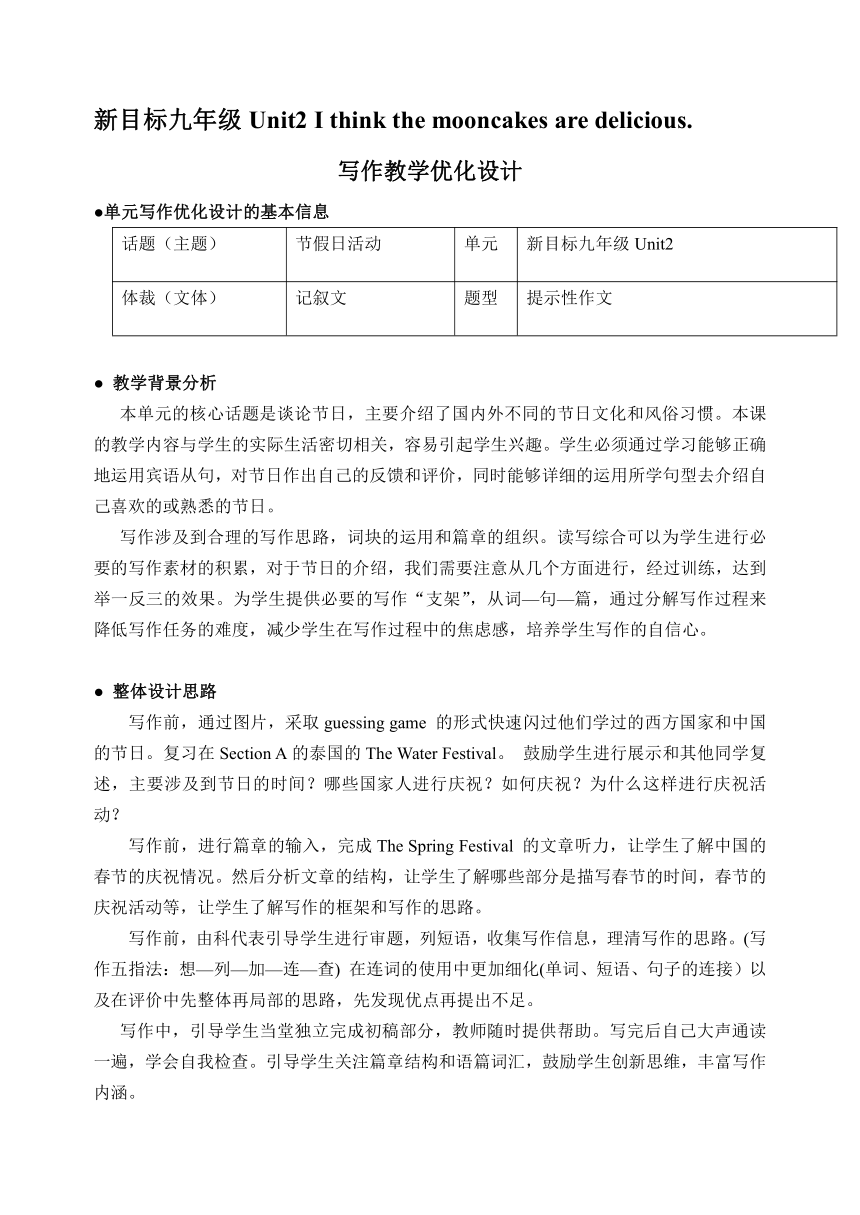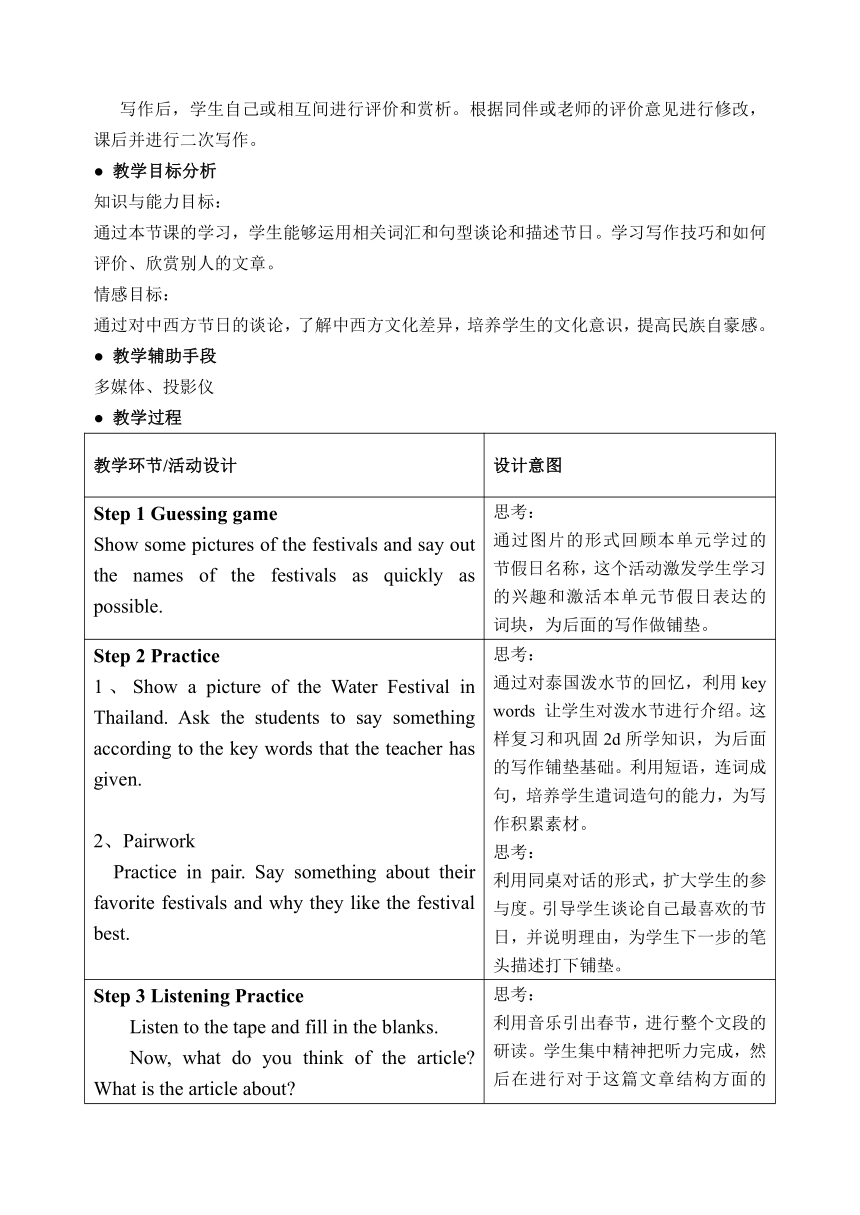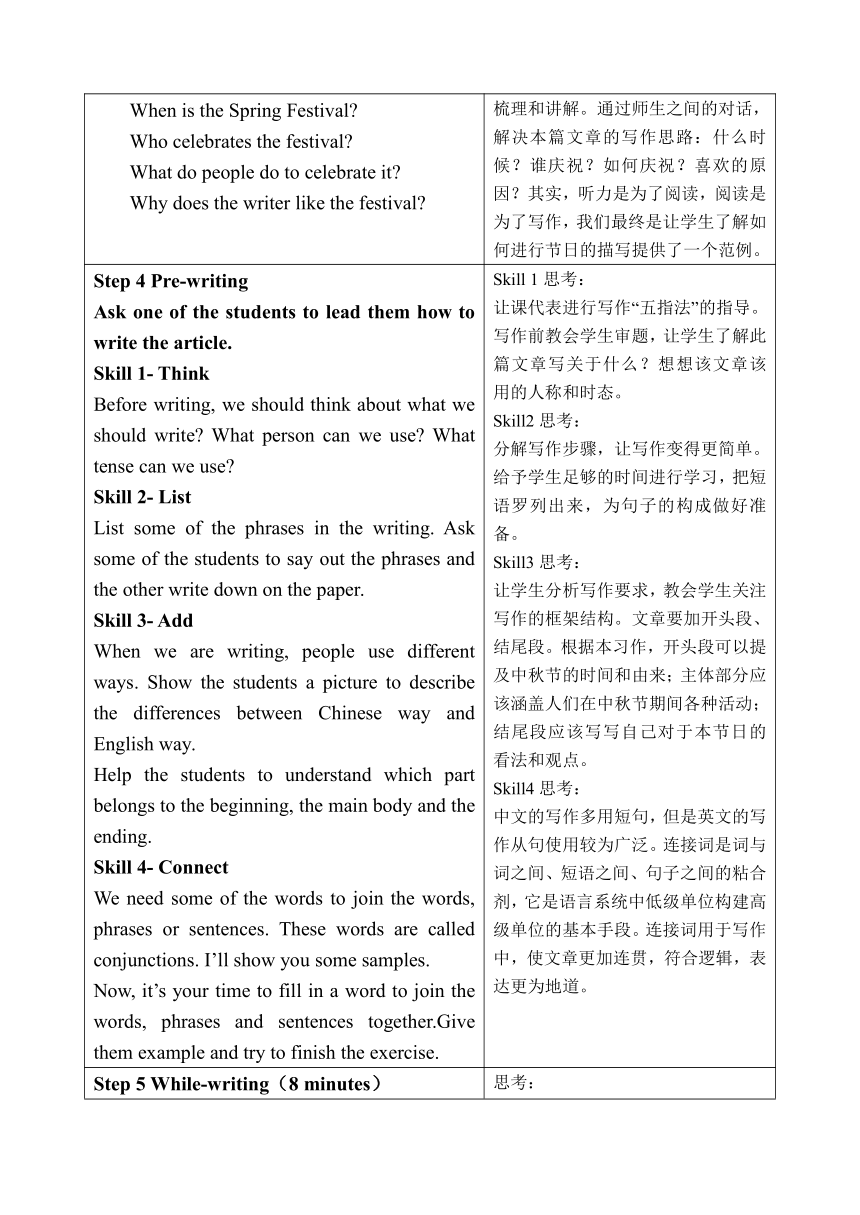Unit 2 I think that mooncakes are delicious!SectionA Grammar focus 4a-4c 教案
文档属性
| 名称 | Unit 2 I think that mooncakes are delicious!SectionA Grammar focus 4a-4c 教案 |  | |
| 格式 | doc | ||
| 文件大小 | 71.5KB | ||
| 资源类型 | 教案 | ||
| 版本资源 | 人教新目标(Go for it)版 | ||
| 科目 | 英语 | ||
| 更新时间 | 2022-11-07 15:13:56 | ||
图片预览



文档简介
新目标九年级Unit2 I think the mooncakes are delicious.
写作教学优化设计
●单元写作优化设计的基本信息
话题(主题) 节假日活动 单元 新目标九年级Unit2
体裁(文体) 记叙文 题型 提示性作文
● 教学背景分析
本单元的核心话题是谈论节日,主要介绍了国内外不同的节日文化和风俗习惯。本课的教学内容与学生的实际生活密切相关,容易引起学生兴趣。学生必须通过学习能够正确地运用宾语从句,对节日作出自己的反馈和评价,同时能够详细的运用所学句型去介绍自己喜欢的或熟悉的节日。
写作涉及到合理的写作思路,词块的运用和篇章的组织。读写综合可以为学生进行必要的写作素材的积累,对于节日的介绍,我们需要注意从几个方面进行,经过训练,达到举一反三的效果。为学生提供必要的写作“支架”,从词—句—篇,通过分解写作过程来降低写作任务的难度,减少学生在写作过程中的焦虑感,培养学生写作的自信心。
● 整体设计思路
写作前,通过图片,采取guessing game 的形式快速闪过他们学过的西方国家和中国的节日。复习在Section A的泰国的The Water Festival。 鼓励学生进行展示和其他同学复述,主要涉及到节日的时间?哪些国家人进行庆祝?如何庆祝?为什么这样进行庆祝活动?
写作前,进行篇章的输入,完成The Spring Festival 的文章听力,让学生了解中国的春节的庆祝情况。然后分析文章的结构,让学生了解哪些部分是描写春节的时间,春节的庆祝活动等,让学生了解写作的框架和写作的思路。
写作前,由科代表引导学生进行审题,列短语,收集写作信息,理清写作的思路。(写作五指法:想—列—加—连—查) 在连词的使用中更加细化(单词、短语、句子的连接)以及在评价中先整体再局部的思路,先发现优点再提出不足。
写作中,引导学生当堂独立完成初稿部分,教师随时提供帮助。写完后自己大声通读一遍,学会自我检查。引导学生关注篇章结构和语篇词汇,鼓励学生创新思维,丰富写作内涵。
写作后,学生自己或相互间进行评价和赏析。根据同伴或老师的评价意见进行修改,课后并进行二次写作。
● 教学目标分析
知识与能力目标:
通过本节课的学习,学生能够运用相关词汇和句型谈论和描述节日。学习写作技巧和如何评价、欣赏别人的文章。
情感目标:
通过对中西方节日的谈论,了解中西方文化差异,培养学生的文化意识,提高民族自豪感。
● 教学辅助手段
多媒体、投影仪
● 教学过程
教学环节/活动设计 设计意图
Step 1 Guessing gameShow some pictures of the festivals and say out the names of the festivals as quickly as possible. 思考:通过图片的形式回顾本单元学过的节假日名称,这个活动激发学生学习的兴趣和激活本单元节假日表达的词块,为后面的写作做铺垫。
Step 2 Practice 1、Show a picture of the Water Festival in Thailand. Ask the students to say something according to the key words that the teacher has given. 2、Pairwork Practice in pair. Say something about their favorite festivals and why they like the festival best. 思考:通过对泰国泼水节的回忆,利用key words 让学生对泼水节进行介绍。这样复习和巩固2d所学知识,为后面的写作铺垫基础。利用短语,连词成句,培养学生遣词造句的能力,为写作积累素材。思考:利用同桌对话的形式,扩大学生的参与度。引导学生谈论自己最喜欢的节日,并说明理由,为学生下一步的笔头描述打下铺垫。
Step 3 Listening PracticeListen to the tape and fill in the blanks. Now, what do you think of the article What is the article about When is the Spring Festival Who celebrates the festival What do people do to celebrate it Why does the writer like the festival 思考:利用音乐引出春节,进行整个文段的研读。学生集中精神把听力完成,然后在进行对于这篇文章结构方面的梳理和讲解。通过师生之间的对话,解决本篇文章的写作思路:什么时候?谁庆祝?如何庆祝?喜欢的原因?其实,听力是为了阅读,阅读是为了写作,我们最终是让学生了解如何进行节日的描写提供了一个范例。
Step 4 Pre-writingAsk one of the students to lead them how to write the article. Skill 1- ThinkBefore writing, we should think about what we should write What person can we use What tense can we use Skill 2- ListList some of the phrases in the writing. Ask some of the students to say out the phrases and the other write down on the paper.Skill 3- AddWhen we are writing, people use different ways. Show the students a picture to describe the differences between Chinese way and English way.Help the students to understand which part belongs to the beginning, the main body and the ending.Skill 4- ConnectWe need some of the words to join the words, phrases or sentences. These words are called conjunctions. I’ll show you some samples. Now, it’s your time to fill in a word to join the words, phrases and sentences together.Give them example and try to finish the exercise. Skill 1思考:让课代表进行写作“五指法”的指导。写作前教会学生审题,让学生了解此篇文章写关于什么?想想该文章该用的人称和时态。Skill2思考:分解写作步骤,让写作变得更简单。给予学生足够的时间进行学习,把短语罗列出来,为句子的构成做好准备。Skill3思考:让学生分析写作要求,教会学生关注写作的框架结构。文章要加开头段、结尾段。根据本习作,开头段可以提及中秋节的时间和由来;主体部分应该涵盖人们在中秋节期间各种活动;结尾段应该写写自己对于本节日的看法和观点。Skill4思考:中文的写作多用短句,但是英文的写作从句使用较为广泛。连接词是词与词之间、短语之间、句子之间的粘合剂,它是语言系统中低级单位构建高级单位的基本手段。连接词用于写作中,使文章更加连贯,符合逻辑,表达更为地道。
Step 5 While-writing(8 minutes)Ask one of the students to write the article on the blackboard and the other students start to write the article on their Learning Guide. While writing, the teacher goes around the class and offer help if it is necessary. 思考:学生的学习过程既要有大脑被激活时的兴奋、活跃的状态,也要有静下心来思考的时间。让学生在课堂上限时间写作,既能保证学生写作的时间,又能提高写作效率。同时,写作的提高并不是以考代练,在写作课上,学生是可以向同学或老师寻求帮助。
Step 6 Post-writing(5 minutes)First, read your own writing aloud and then check it by yourself.Skill 5- CheckAsk some of the students to make comments on the writing on the blackboard. (Present two more writing by using the projector and ask the students to make comments on the writing.Then students exchange their writing with each other, and then make comments on other’s writing. 思考:写完习作后,先自己大声朗读,自己检查一遍。检查的时候,先从篇章结构,接着句子方面,然后用词方面,最后是标点符号、大小写的细节问题。在评论别人的习作,也要以这样的顺序,要从大范围再到小范围,找出习作的亮点句,最后提出个别错误及如何改善。思考:首先直接学生写好在黑板上的文章进行点评,这样范例作用,教会学生如何点评别人的文章。接着抽查3个同学的文章用投影仪展示,让学生巩固文章的检查方法,让学生点评并给予分数的评价。最后交换互评。
Step 7 Summary We have learn some of the writing skills: 思考:总结描写节假日需要注意的地方以及所运用到的写作技巧:想-列-加-连-查。
Worksheet for Writing
Unit 2 I think the mooncakes are delicious.
1) Listen and fill in the blanks.
Spring Festival is one of the most important ____________________ festivals. It’s on January 1 of the lunar calendar. It usually lasts for __________ days.
Before the festival, people __________________. We think cleaning can sweep the bad luck. At the same time, we ______________ the red couplets (对联). On the eve of the festival, family members _______________ and have a big meal. Then we watch the Spring Festival Gala on TV. At midnight, we set off fireworks (烟花) to welcome the New Year. During the festival, kids get ________________ from the old. We visit our relatives and friends and we are all happy.
I like the festival because I can do lots of interesting things, such as playing cards and visiting relatives.
2) How can we write an article about festivals
Festivals
3) Writing Task
假如你是李明,你的英国网友Susan想向你了解一些关于中国传统节日——中秋节的情况。请给她写一封电子邮件,介绍一下中秋节。内容包括:
1. 介绍中秋节的时间,节日由来等;
2. 介绍人们如何庆祝该节日;
3. 说明自己为何喜欢这个节日。
写作要求:1. 不能抄袭原文;不得在作文中出现学校的真实名称和学生的真实姓名
2. 语句连贯,词数80个左右,开头已经给出,不计入总词数。
参考词汇:lunar calendar(农历) ;legend(传说)
【思路点拨】
第一步:审题:人称____________ 时态_____________
第二步:列提纲
第一段:开篇点题,介绍中秋节的时间、节日由来。参考句型:
(1) In China, one of the most popular festivals is….
(2) It comes on … of the lunar calendar.
(3) Chinese people celebrate it to remember and honor….
第二段:介绍人们如何庆祝该节日。参考句型:
(1) On this day, people… (2) At night, they …
第三段:总结全文,说明自己为何喜欢这个节日。参考句型:
I love … not only because of …, but….
第三步:列出主要的单词、短语和句型。
1. 最受欢迎的节日之一__________________________
2. 和某人聚在一起_____________________________
3. 摆出_______________________________________
4. 赏月_______________________________________
5. 不但……而且…… __________________________
第四步: 运用and, or, so, first, then…等连接词将以上要点连成文章, 注意句型多样化。
难点:
__________________________________________________________________________
__________________________________________________________________________
__________________________________________________________________________
__________________________________________________________________________
__________________________________________________________________________
__________________________________________________________________________
__________________________________________________________________________
__________________________________________________________________________
__________________________________________________________________________
__________________________________________________________________________
__________________________________________________________________________
PAGE
写作教学优化设计
●单元写作优化设计的基本信息
话题(主题) 节假日活动 单元 新目标九年级Unit2
体裁(文体) 记叙文 题型 提示性作文
● 教学背景分析
本单元的核心话题是谈论节日,主要介绍了国内外不同的节日文化和风俗习惯。本课的教学内容与学生的实际生活密切相关,容易引起学生兴趣。学生必须通过学习能够正确地运用宾语从句,对节日作出自己的反馈和评价,同时能够详细的运用所学句型去介绍自己喜欢的或熟悉的节日。
写作涉及到合理的写作思路,词块的运用和篇章的组织。读写综合可以为学生进行必要的写作素材的积累,对于节日的介绍,我们需要注意从几个方面进行,经过训练,达到举一反三的效果。为学生提供必要的写作“支架”,从词—句—篇,通过分解写作过程来降低写作任务的难度,减少学生在写作过程中的焦虑感,培养学生写作的自信心。
● 整体设计思路
写作前,通过图片,采取guessing game 的形式快速闪过他们学过的西方国家和中国的节日。复习在Section A的泰国的The Water Festival。 鼓励学生进行展示和其他同学复述,主要涉及到节日的时间?哪些国家人进行庆祝?如何庆祝?为什么这样进行庆祝活动?
写作前,进行篇章的输入,完成The Spring Festival 的文章听力,让学生了解中国的春节的庆祝情况。然后分析文章的结构,让学生了解哪些部分是描写春节的时间,春节的庆祝活动等,让学生了解写作的框架和写作的思路。
写作前,由科代表引导学生进行审题,列短语,收集写作信息,理清写作的思路。(写作五指法:想—列—加—连—查) 在连词的使用中更加细化(单词、短语、句子的连接)以及在评价中先整体再局部的思路,先发现优点再提出不足。
写作中,引导学生当堂独立完成初稿部分,教师随时提供帮助。写完后自己大声通读一遍,学会自我检查。引导学生关注篇章结构和语篇词汇,鼓励学生创新思维,丰富写作内涵。
写作后,学生自己或相互间进行评价和赏析。根据同伴或老师的评价意见进行修改,课后并进行二次写作。
● 教学目标分析
知识与能力目标:
通过本节课的学习,学生能够运用相关词汇和句型谈论和描述节日。学习写作技巧和如何评价、欣赏别人的文章。
情感目标:
通过对中西方节日的谈论,了解中西方文化差异,培养学生的文化意识,提高民族自豪感。
● 教学辅助手段
多媒体、投影仪
● 教学过程
教学环节/活动设计 设计意图
Step 1 Guessing gameShow some pictures of the festivals and say out the names of the festivals as quickly as possible. 思考:通过图片的形式回顾本单元学过的节假日名称,这个活动激发学生学习的兴趣和激活本单元节假日表达的词块,为后面的写作做铺垫。
Step 2 Practice 1、Show a picture of the Water Festival in Thailand. Ask the students to say something according to the key words that the teacher has given. 2、Pairwork Practice in pair. Say something about their favorite festivals and why they like the festival best. 思考:通过对泰国泼水节的回忆,利用key words 让学生对泼水节进行介绍。这样复习和巩固2d所学知识,为后面的写作铺垫基础。利用短语,连词成句,培养学生遣词造句的能力,为写作积累素材。思考:利用同桌对话的形式,扩大学生的参与度。引导学生谈论自己最喜欢的节日,并说明理由,为学生下一步的笔头描述打下铺垫。
Step 3 Listening PracticeListen to the tape and fill in the blanks. Now, what do you think of the article What is the article about When is the Spring Festival Who celebrates the festival What do people do to celebrate it Why does the writer like the festival 思考:利用音乐引出春节,进行整个文段的研读。学生集中精神把听力完成,然后在进行对于这篇文章结构方面的梳理和讲解。通过师生之间的对话,解决本篇文章的写作思路:什么时候?谁庆祝?如何庆祝?喜欢的原因?其实,听力是为了阅读,阅读是为了写作,我们最终是让学生了解如何进行节日的描写提供了一个范例。
Step 4 Pre-writingAsk one of the students to lead them how to write the article. Skill 1- ThinkBefore writing, we should think about what we should write What person can we use What tense can we use Skill 2- ListList some of the phrases in the writing. Ask some of the students to say out the phrases and the other write down on the paper.Skill 3- AddWhen we are writing, people use different ways. Show the students a picture to describe the differences between Chinese way and English way.Help the students to understand which part belongs to the beginning, the main body and the ending.Skill 4- ConnectWe need some of the words to join the words, phrases or sentences. These words are called conjunctions. I’ll show you some samples. Now, it’s your time to fill in a word to join the words, phrases and sentences together.Give them example and try to finish the exercise. Skill 1思考:让课代表进行写作“五指法”的指导。写作前教会学生审题,让学生了解此篇文章写关于什么?想想该文章该用的人称和时态。Skill2思考:分解写作步骤,让写作变得更简单。给予学生足够的时间进行学习,把短语罗列出来,为句子的构成做好准备。Skill3思考:让学生分析写作要求,教会学生关注写作的框架结构。文章要加开头段、结尾段。根据本习作,开头段可以提及中秋节的时间和由来;主体部分应该涵盖人们在中秋节期间各种活动;结尾段应该写写自己对于本节日的看法和观点。Skill4思考:中文的写作多用短句,但是英文的写作从句使用较为广泛。连接词是词与词之间、短语之间、句子之间的粘合剂,它是语言系统中低级单位构建高级单位的基本手段。连接词用于写作中,使文章更加连贯,符合逻辑,表达更为地道。
Step 5 While-writing(8 minutes)Ask one of the students to write the article on the blackboard and the other students start to write the article on their Learning Guide. While writing, the teacher goes around the class and offer help if it is necessary. 思考:学生的学习过程既要有大脑被激活时的兴奋、活跃的状态,也要有静下心来思考的时间。让学生在课堂上限时间写作,既能保证学生写作的时间,又能提高写作效率。同时,写作的提高并不是以考代练,在写作课上,学生是可以向同学或老师寻求帮助。
Step 6 Post-writing(5 minutes)First, read your own writing aloud and then check it by yourself.Skill 5- CheckAsk some of the students to make comments on the writing on the blackboard. (Present two more writing by using the projector and ask the students to make comments on the writing.Then students exchange their writing with each other, and then make comments on other’s writing. 思考:写完习作后,先自己大声朗读,自己检查一遍。检查的时候,先从篇章结构,接着句子方面,然后用词方面,最后是标点符号、大小写的细节问题。在评论别人的习作,也要以这样的顺序,要从大范围再到小范围,找出习作的亮点句,最后提出个别错误及如何改善。思考:首先直接学生写好在黑板上的文章进行点评,这样范例作用,教会学生如何点评别人的文章。接着抽查3个同学的文章用投影仪展示,让学生巩固文章的检查方法,让学生点评并给予分数的评价。最后交换互评。
Step 7 Summary We have learn some of the writing skills: 思考:总结描写节假日需要注意的地方以及所运用到的写作技巧:想-列-加-连-查。
Worksheet for Writing
Unit 2 I think the mooncakes are delicious.
1) Listen and fill in the blanks.
Spring Festival is one of the most important ____________________ festivals. It’s on January 1 of the lunar calendar. It usually lasts for __________ days.
Before the festival, people __________________. We think cleaning can sweep the bad luck. At the same time, we ______________ the red couplets (对联). On the eve of the festival, family members _______________ and have a big meal. Then we watch the Spring Festival Gala on TV. At midnight, we set off fireworks (烟花) to welcome the New Year. During the festival, kids get ________________ from the old. We visit our relatives and friends and we are all happy.
I like the festival because I can do lots of interesting things, such as playing cards and visiting relatives.
2) How can we write an article about festivals
Festivals
3) Writing Task
假如你是李明,你的英国网友Susan想向你了解一些关于中国传统节日——中秋节的情况。请给她写一封电子邮件,介绍一下中秋节。内容包括:
1. 介绍中秋节的时间,节日由来等;
2. 介绍人们如何庆祝该节日;
3. 说明自己为何喜欢这个节日。
写作要求:1. 不能抄袭原文;不得在作文中出现学校的真实名称和学生的真实姓名
2. 语句连贯,词数80个左右,开头已经给出,不计入总词数。
参考词汇:lunar calendar(农历) ;legend(传说)
【思路点拨】
第一步:审题:人称____________ 时态_____________
第二步:列提纲
第一段:开篇点题,介绍中秋节的时间、节日由来。参考句型:
(1) In China, one of the most popular festivals is….
(2) It comes on … of the lunar calendar.
(3) Chinese people celebrate it to remember and honor….
第二段:介绍人们如何庆祝该节日。参考句型:
(1) On this day, people… (2) At night, they …
第三段:总结全文,说明自己为何喜欢这个节日。参考句型:
I love … not only because of …, but….
第三步:列出主要的单词、短语和句型。
1. 最受欢迎的节日之一__________________________
2. 和某人聚在一起_____________________________
3. 摆出_______________________________________
4. 赏月_______________________________________
5. 不但……而且…… __________________________
第四步: 运用and, or, so, first, then…等连接词将以上要点连成文章, 注意句型多样化。
难点:
__________________________________________________________________________
__________________________________________________________________________
__________________________________________________________________________
__________________________________________________________________________
__________________________________________________________________________
__________________________________________________________________________
__________________________________________________________________________
__________________________________________________________________________
__________________________________________________________________________
__________________________________________________________________________
__________________________________________________________________________
PAGE
同课章节目录
- Unit 1 How can we become good learners.
- Section A
- Section B
- Unit 2 I think that mooncakes are delicious!
- Section A
- Section B
- Unit 3 Could you please tell me where the restroom
- Section A
- Section B
- Unit 4 I used to be afraid of the dark.
- Section A
- Section B
- Unit 5 What are the shirts made of?
- Section A
- Section B
- Review of Units 1-5
- Unit 6 When was it invented?
- Section A
- Section B
- Unit 7 Teenagers should be allowed to choose their
- Section A
- Section B
- Unit 8 It must belong to Carla.
- Section A
- Section B
- Unit 9 I like music that I can dance to.
- Section A
- Section B
- Unit 10 You're supposed to shake hands.
- Section A
- Section B
- Review of Units 6-10
- Unit 11 Sad movies make me cry.
- Section A
- Section B
- Unit 12 Life is full of the unexpected
- Section A
- Section B
- Unit 13 We're trying to save the earth!
- Section A
- Section B
- Unit 14 I remember meeting all of you in Grade 7.
- Section A
- Section B
- Review of Units 11-14
